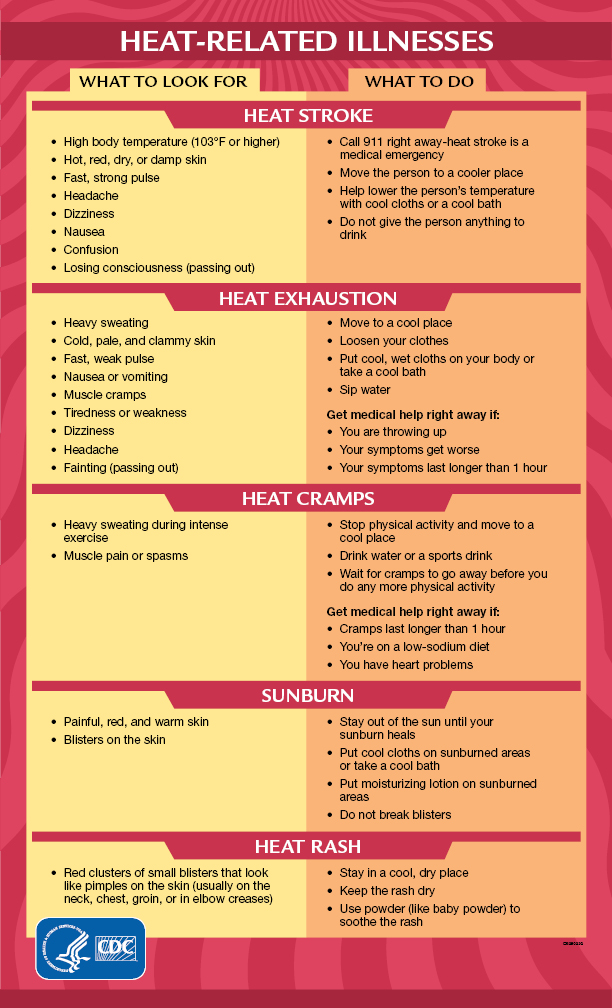This page explains what actions you can take when the weather is extremely hot and how to understand heat alerts from the National Weather Service that you could receive in your local area. Heat kills by pushing the human body beyond its limits. In extreme heat and high humidity, evaporation is slowed and the body must work extra hard to maintain a normal temperature.
Key Safety Tips
- Drink plenty of water; even if you do not feel thirsty. Avoid drinks with caffeine. Persons who have epilepsy or heart, kidney, or liver disease; are on fluid-restricted diets; or have a problem with fluid retention should consult a doctor before increasing liquid intake.
- Never leave children or pets alone in closed vehicles.
- Check on family, friends, and neighbors who do not have air conditioning and who spend much of their time alone.
- Check on your animals frequently to ensure that they are not suffering from the heat.
- Go to a designated public shelter if your home loses power during periods of extreme heat. Stay on the lowest floor out of the sunshine if air conditioning is not available.
- Check the weather/listen to NOAA Weather Radio for critical updates from the National Weather Service (NWS).
- Check the National Weather Service Interactive Heat Risk Map
Safety Tips if You Have to Go Outside
- Avoid strenuous work during the warmest part of the day. Use a buddy system when working in extreme heat, and take frequent breaks.
- Dress in loose-fitting, lightweight, and light-colored clothes that cover as much skin as possible. Avoid dark colors because they absorb the sun’s rays.
- Protect face and head by wearing sunblock and a wide-brimmed hat.
- Postpone outdoor games and activities.
- Stay indoors as much as possible and limit exposure to the sun.
Additional Safety Tips
- Eat well-balanced, light, and regular meals. Avoid using salt tablets unless directed to do so by a physician.
- Limit intake of alcoholic beverages.
- Avoid extreme temperature changes.
- Consider spending the warmest part of the day in public buildings such as libraries, schools, movie theaters, shopping malls, and other community facilities. Circulating air can cool the body by increasing the perspiration rate of evaporation.
- Download the FEMA App for heat advisories and safety tips.
- Text SHELTER + your ZIP code to 43362 (4FEMA) to find the nearest shelter in your area (example: shelter 12345).
Safety Tips Before Extreme Heat Arrives
- To begin preparing, you should build an emergency kit and make a family communications plan.
- Know those in your neighborhood who are older, young, sick or overweight. They are more likely to become victims of excessive heat and may need help.
- Be aware that people living in urban areas may be at greater risk from the effects of a prolonged heat wave than are people living in rural areas.
- Get trained in first aid to learn how to treat heat-related emergencies.
Tips to Prepare Your Home
- Install window air conditioners snugly; insulate if necessary.
- Check air-conditioning ducts for proper insulation.
- Install temporary window reflectors (for use between windows and drapes), such as aluminum foil-covered cardboard, to reflect heat back outside.
- Weather-strip doors and sills to keep cool air in.
- Cover windows that receive morning or afternoon sun with drapes, shades, awnings, or louvers. (Outdoor awnings or louvers can reduce the heat that enters a home by up to 80 percent.)
- Keep storm windows up all year.
Prepare For Extreme Heat Conditions


Heat Related Terms
Familiarize yourself with these terms to help identify an extreme heat hazard:
- Heat Wave - Prolonged period of excessive heat, often combined with excessive humidity.
- Heat Index - A number in degrees Fahrenheit (F) that tells how hot it feels when relative humidity is added to the air temperature. Exposure to full sunshine can increase the heat index by 15 degrees.

- Heat Cramps - Muscular pains and spasms due to heavy exertion. Although heat cramps are the least severe, they are often the first signal that the body is having trouble with the heat.
- Heat Exhaustion - Typically occurs when people exercise heavily or work in a hot, humid place where body fluids are lost through heavy sweating. Blood flow to the skin increases, causing blood flow to decrease to the vital organs. This results in a form of mild shock. If not treated, the victim's condition will worsen. Body temperature will keep rising and the victim may suffer heat stroke.
- Heat Stroke - A life-threatening condition. The victim's temperature control system, which produces sweating to cool the body, stops working. The body temperature can rise so high that brain damage and death may result if the body is not cooled quickly.
- Sun Stroke - Another term for heat stroke.
- Excessive Heat Watch - Conditions are favorable for an excessive heat event to meet or exceed local Excessive Heat Warning criteria in the next 24 to 72 hours.
- Excessive Heat Warning - Heat Index values are forecast to meet or exceed locally defined warning criteria for at least 2 days (daytime highs=105-110° Fahrenheit).
- Heat Advisory - Heat Index values are forecast to meet locally defined advisory criteria for 1 to 2 days (daytime highs=100-105° Fahrenheit).
Related Links
- American Red Cross
- Centers for Disease Control and Prevention
- National Integrated Drought Information System
- National Integrated Heat Health Information System
- Online Shareables
- Extreme Heat Safety Social Media Toolkit
- National Weather Service Interactive Heat Risk Map

 From Ready.gov
From Ready.gov





